
I will call this space "Behind the music". Of course my musical tastes come from the Classical period, Romanticism (with its great verismo) and impressionism in the last rung. On the platform I dream of performing commercial songs, covers and original songs. But my career is managed in the aforementioned periods, since I am a lyrical singer and opera is my greatest delusion.
Music is given how many know since prehistoric times, and although little is known, the conservation of instruments and hieroglyphics that leave us a recorded history, mark the beginning of this great discipline. Developing in itself, the conception of new spaces and the characteristics written by historians and musicologists give a new time line that is considered as Middle Ages or Antiquity, transcended with its limitations by the church, politics and regional kings, becoming in the Age of the Renaissance, where the knowledge of man becomes more notorious, and the importance of it has greater value, because until now the church prevails.
Next we have the Baroque, with great composers and the birth of opera, theatrical art and music written for the delight and not only for the church, it becomes the most direct path to the exaltation of music and its great prestige, and we can notice it a few centuries later with the arrival of the Classical period, with rigidity but with the projection of feeling within the music and singing, it is later transformed into the Romantic passages and the most Veristic works of the Romantic Period.
We could spend years talking about each period, its development and how each one was perfected, even with the technical guidelines they had. But today in this timeline we just want to give an instruction to this new space.
“Il Bianco E Dolce Cigno” by Jacques Arcadelt
LET'S DO IT
Today I would like to start with a simple work entitled “Il Bianco E Dolce Cigno” by Jacques Arcadelt.
Jacques Arcadelt was born on August 10, 1507 in Namur, formerly part of Burgundy, and what is currently part of the Netherlands. J. Arcadelt published his first four books on madrigals, being “Il bianco e dolce cigno” part of his first book, after which it became master of the Sistine Chapel, then he went to France where he has to publish some works.
Arcadelt is recognized for his secular music, although he also composed sacred music. Jacques Arcadelt died on October 14, 1568 in the city of Paris.
The poetry of “Il bianco e dolce cigno” belongs to the poet and bishop Giovanni Guidiccioni, born on February 25, 1500 and studied Letters and Philosophy, and was in charge of important positions such as Governor of Rome, Bishop of Fossombrone and Pontifical in Spain.
Guidiccioni fallece el 26 de julio de 1541.
At first we can see a composition for 4 voices, in the first bars the 3 upper voices enter and later the bass. The first 2 bars present us with a homophonic movement on F and where the tenor begins with an interval of perfect fourths and then the tenor and alto voices have a movement of parallel thirds characteristic of the time.
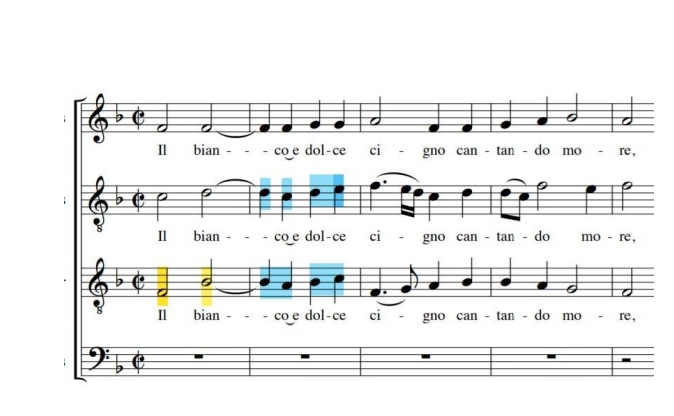
The text says: Il bianco e dolce cigno cantando more and its translation into Spanish is: The swan white and sweet singing dies, musically you can see a kind of fluttering (of the swan), a quite common idea in the renaissance madrigal, it is not only the text and the music, but both arts coexist to make a whole musical structure. Then in bar 5 the bass voice enters, accompanied by the alto and tenor voices, and a tempo later the soprano voice. In this movement [alto-tenor] and followed by [alto-soprano] performs the interval of a perfect 4th for avoid the tritone, which interpretatively leads to accentuate to emphasize the sentence.
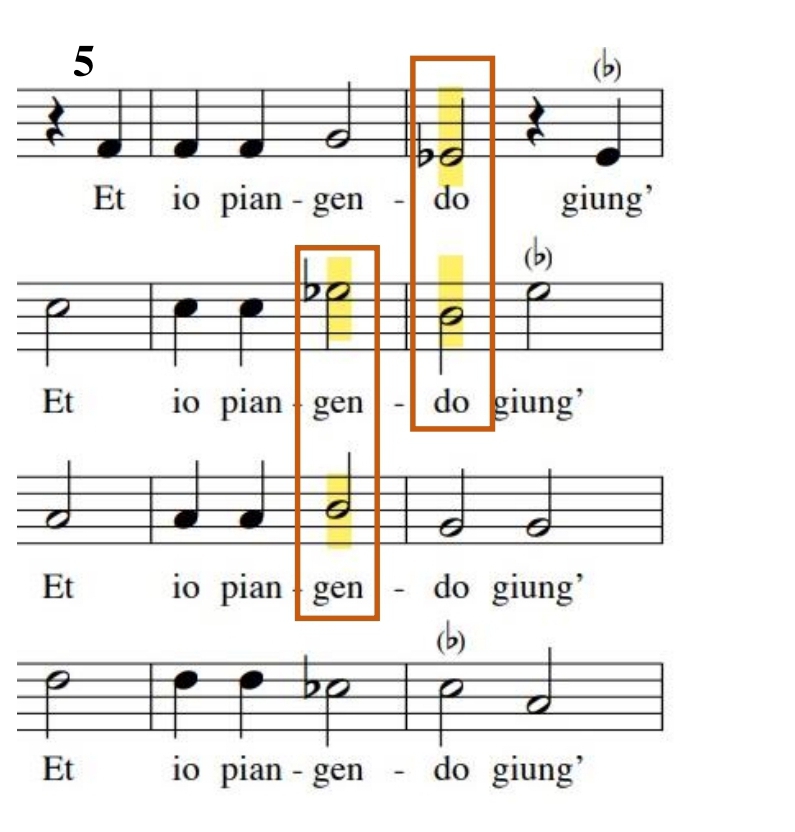
In measure 8 a phrase can be seen on the tenor line, with a slightly different rhythmic motif and which in turn contains a delay on the 4th beat and of course resolved in the following measure, then it will be imitated by the soprano's voice in measure 14, developing exactly the same.
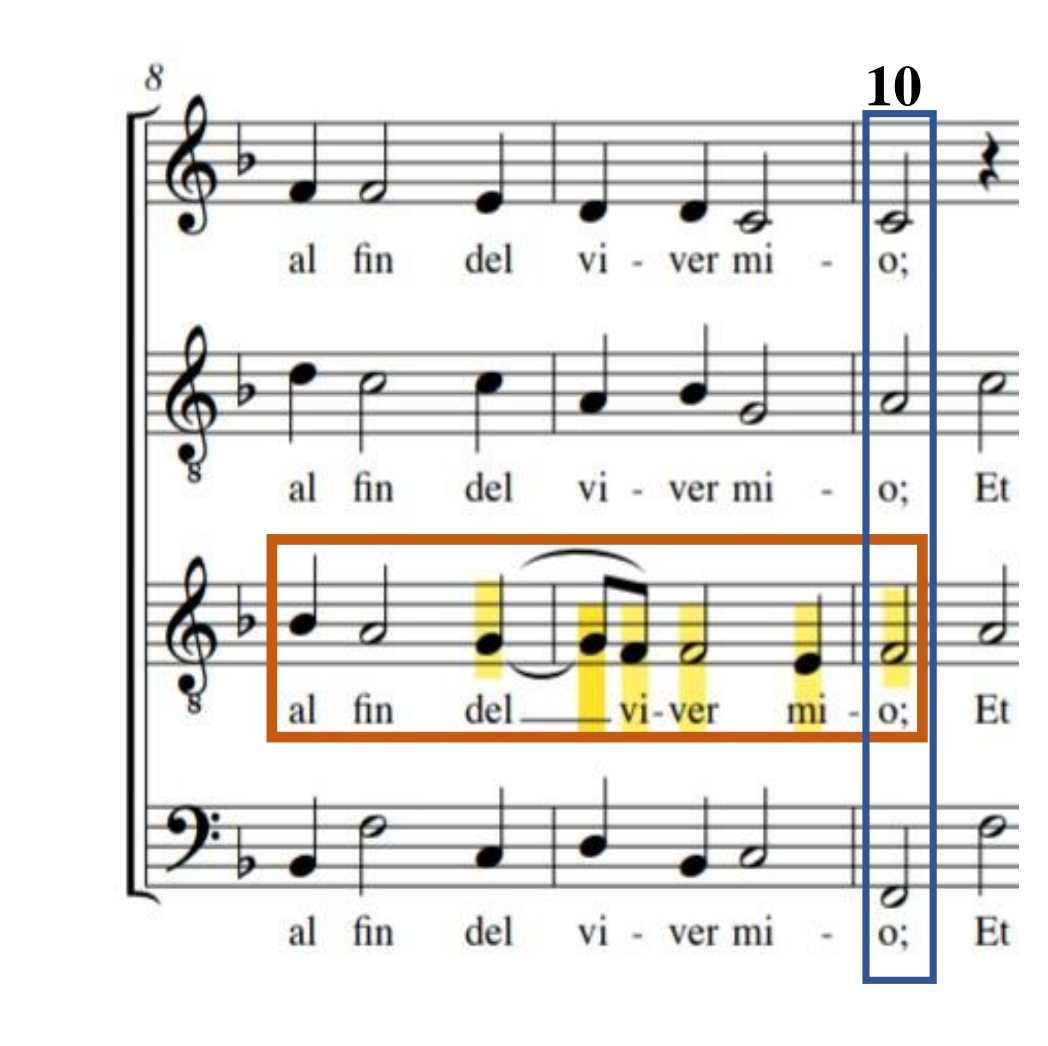
While the imitation occurs, the other voices continue with the song under the text: ed io piangendo, giung' al fin del viver mio, which translates as: and I crying, I reach the end of my life. When the voices say this text we can see how there is a downward movement,
even in bar 10, he makes the lowest notes so far and that he repeats in bar 15.
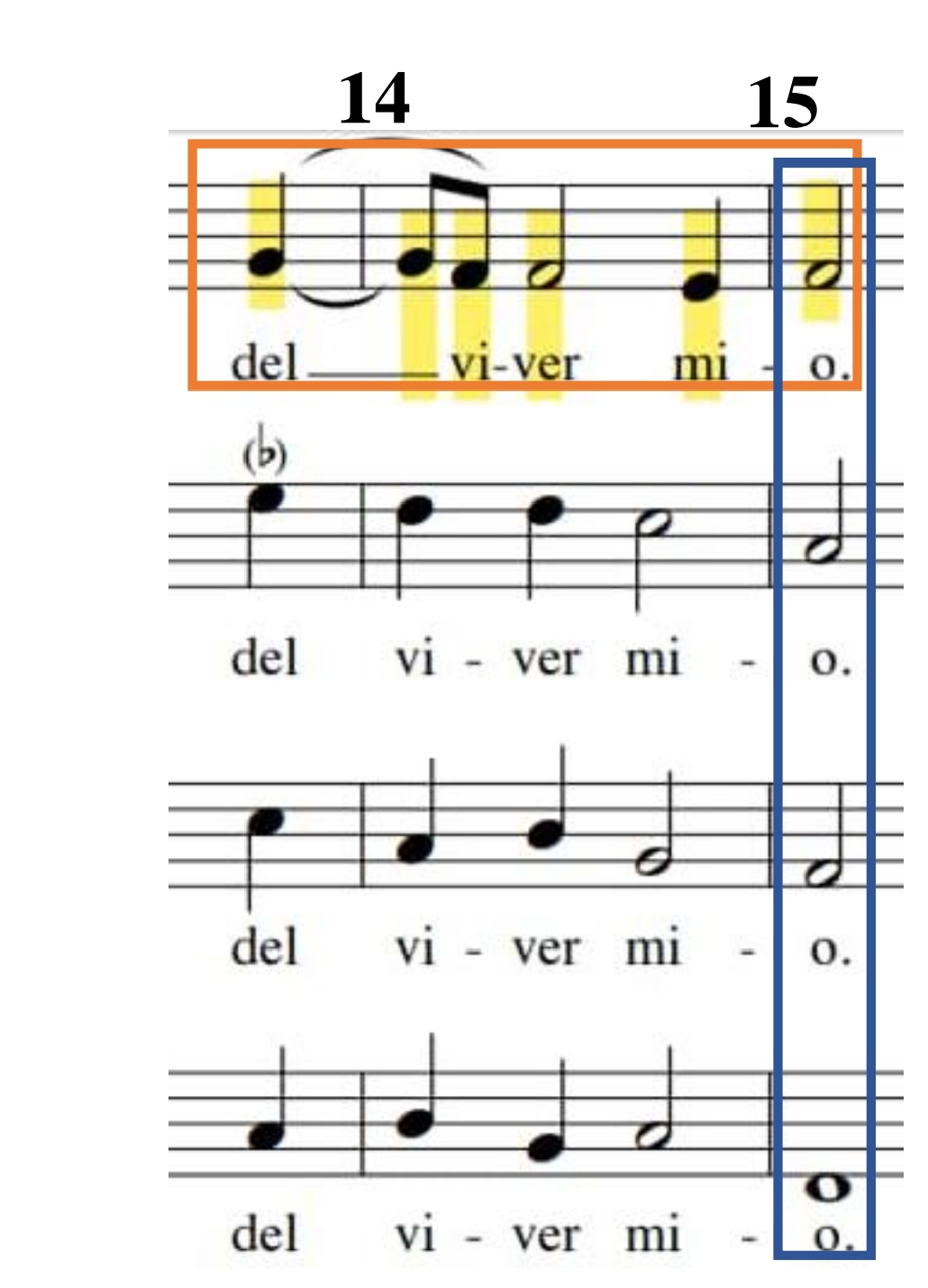
It can be seen that in measure 16 the tenor makes a rhythmic cell from which the bass response then starts and the tenor performs an imitation of the soprano a descending sixth, between alto and tenor the parallel thirds and then in measure 20 , the soprano voice performs a somewhat ornate motif to simulate happiness. It is also the first time that C# and Si♮ appear, and which in turn lead to the change to D aeolian in measure 24.
The quoted text in the previous bars is: Stran' e diversa sorte, ch'ei more sconsolato, ed io moro beato; means: Strange and diverse destiny, that he dies disconsolate, and I die happy. The musical description mentioned above is evident, since it is not only the musical accompaniment, but also how the text describes the moment that causes it.
happiness.
From measure 24 the movement is static, homophonically and also with the opposite movement, “Morte che nel morire” and then when it says “M'empie di gioia tutt' e di desire” changes the movement a bit, making a dissonant chord at bar 28 and followed at bar 29 by a delay that resolves to the lowest chord of the piece equal to bar 10.
In measure 33 you can see how a dissonance (tritone) between the alto and the tenor as part of the delay, which is resolved in measure 34. With the text “Se nel morir' altro dolor non sento" "If in dying I don't feel another pain I feel".
As is evident throughout the composition this contains a text that is secular and in the vernacular, as well as having a consonant rhyme.
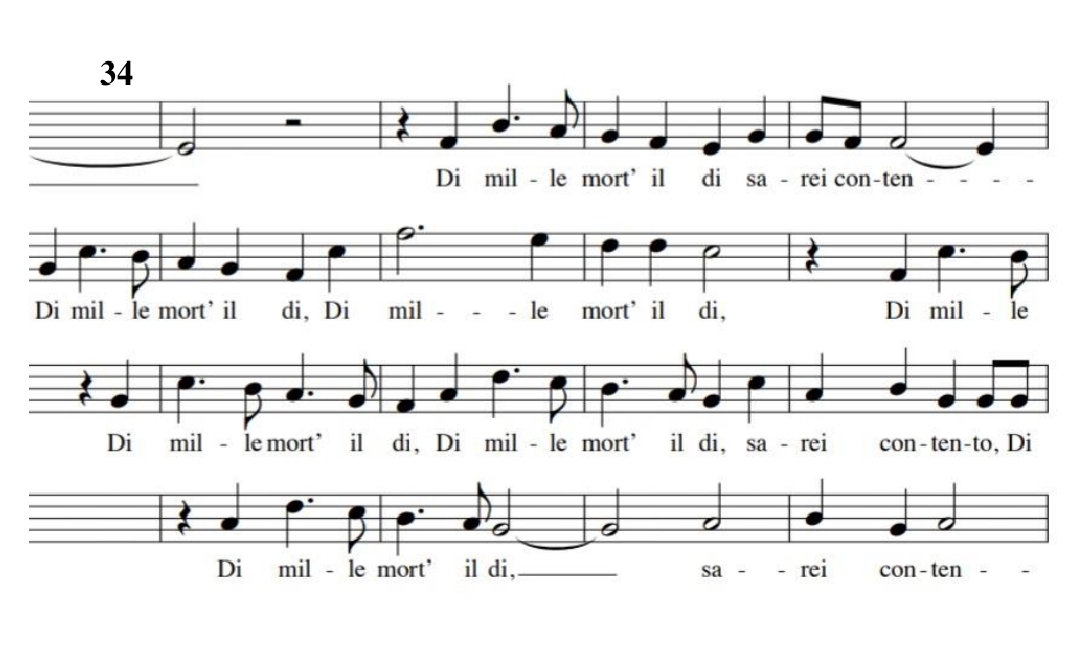
In measure 34 a stretto begins starting from the alto, then tenor, bass and finally soprano, with the text “di mille mort' il di sarei contento” indicating that in this way he would be happy to die a thousand times a day. It is also this motif that uses the base of the motif origina just fourth ascending and then descending minor second.
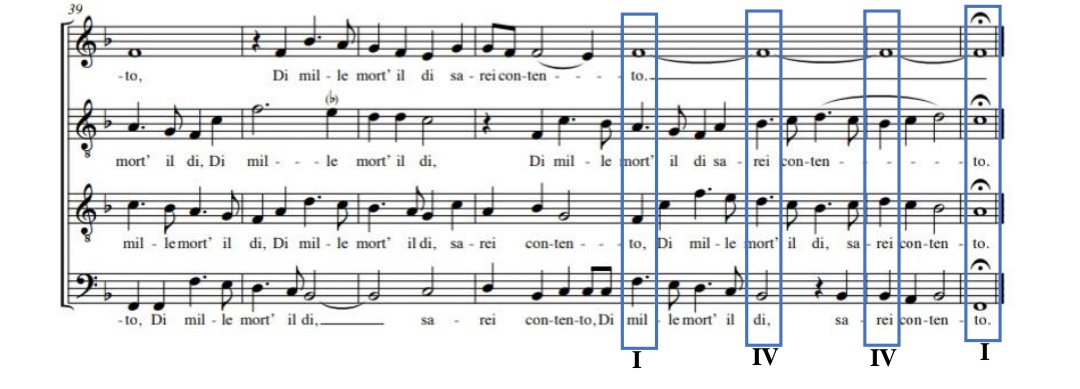
It continues like this until the end of the madrigal where in a repetitive manner and then remaining on a fixed note in the soprano as is customary in the motets and madrigals of the time, it carries out a plagal cadence and that is when it ends in F.
The sheet music was taken from Petrucci's page, where I find most of the sheet music I need IMSLP. Also the complementary information has been taken from link, and about the composer J. Arcadelt, from the next Link
f I hope you liked the analysis of this work and of course it is functional for your interpretation.

The rewards earned on this comment will go directly to the people( @jesuslnrs ) sharing the post on Twitter as long as they are registered with @poshtoken. Sign up at https://hiveposh.com.
Few will comment on this post, but what happens here is not only simple and easy to understand, but I am happy to be one of the few people who can share your analysis. Sitting down and understanding every part of a piece of music from the very basics is beautiful and is the heart of music...
Yes, my goal is to make it understandable for users of this platform and for those who do not know how to do this type of analysis. In this space I will provide tools for us to achieve it together.
Hello @jhoxiris
It is very great you share your knowledge in the field of lyrical music while you are training in this field, thank you for sharing your knowledge in Classical Music with the community!
I could only recommend that in the part where you refer to the author you can put an external link to know where you took the information about him, or otherwise it would be enough with a link that leads us to know more about the author (by the way the link you share is broken: https://www.criticadelibros.com/autores/giovanniguidiccioni), cause he focal point of this publication is your musical analysis.
Have a nice day!
Oh! Yes, thank you very much I had taken the link of the website wrong. And also thanks for your visit and for reading the content, it is a pleasure to share this knowledge on the platform, the ideal is that it be the future complement for those who need it, be it for the musical scope, who wants to interpret the work, or even start a conversation that fills us all with information.
Saludos Jhoxiris, me alegra que te hayas atrevido a compartir lo que amas hacer, sé que a muchos les parecerá un poco difícil, de hecho yo tengo años sin tomar una partitura, pero poder leerte en esta oportunidad me hizo recordar que debo volver a mis estudios, éxitos bella.. no importa si no tienes muchos comentarios, lo importante es que hagas lo que te gusta y en el camino encontrarás la manera de transmitir este mensaje y que otros puedan entenderlo, quizás un vídeo explicativo e interactivo resulte. ❤️
Gracias querida Mirelbis. Esto es algo de trabajo continuo y práctica, al tener loco conocimientos básicos podrás volver a esos estudios. Pronto compartiré más de estos análisis.
Excelente querida amiga, para nosotros la verdad todo esto es un mundo nuevo, pero si quisiéramos tomar clases de música profesional, la verdad que todo este arte es maravilloso y es importante nunca dejar de aprender.
Claro que sí, la música es maravillosa y siempre tiene cosas nuevas que regalarnos. Aquí estamos a la orden siempre para lo que necesiten. ❤️